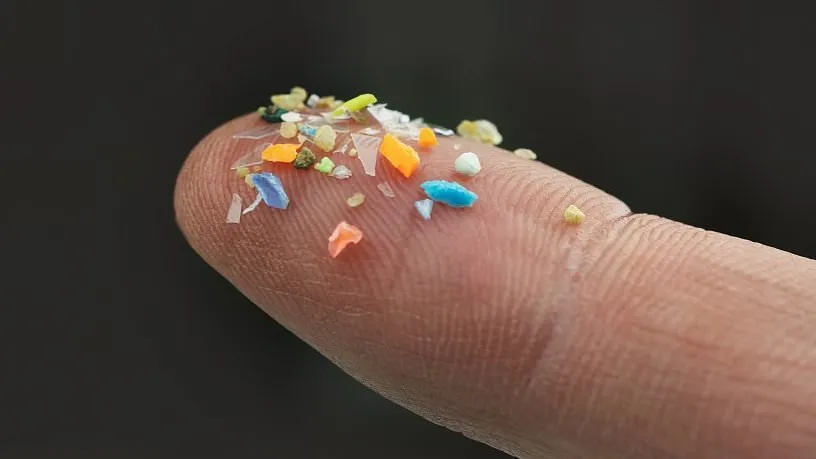By CASSIDY MORRISON SENIOR HEALTH REPORTER FOR DAILYMAIL.COM
The average adult ingests a shocking amount of plastic over their lifetime, according to new research.
WellnessPulse, a wellness and health research platform in the UK and US has revealed a typical 10-year-old has already consumed 6.3lbs of microplastic -- about as much as a lawn chair.
By 40, the average American has swallowed 25lbs -- the same as a household recycling bin.
For those who make it to 80, they will have consumed enough plastic to make a medium-sized canoe.
And the tiny toxic fragments don't just pass through the body.
They're being found lodged in vital organs -- from the brain to the heart -- and are now being linked to everything from cancer and strokes to dementia and pregnancy complications.
'This means that by the end of their lives, Americans may accumulate the amount of microplastics worth nearly three 1.5-liter plastic bottles across their organs and tissues,' the authors said.
People consume about 6.3 lbs of microplastics each decade. Most of them do not stay in the body, but still leave enough to cause harm.
WellnessPulse reviewed 20 studies measuring the levels of microplastics -- tiny particles smaller than five millimeters -- in human tissues.
They collected data on microplastic particle counts, organ weights, and concentration measurements, using both manual methods and AI-assisted tools.
Then, they combined the data by calculating averages across all available measurements to determine the average microplastic concentration in a particular organ.
Microplastics have been detected in the blood and 17 different human organs and tissues, including critical areas like the heart, brain, and reproductive system.
Levels in the blood were the highest of all, measuring 43 times higher than in the brain.
When microplastics enter the bloodstream, they have been shown to attach to artery walls and can raise the risk of a heart attack.
Microplastics in blood, the brain, and other organs have been tied to higher levels of heart attacks, strokes, dementia, liver failure, and pregnancy complications.
Studies identified 17 human organs and tissues that contain microplastics, ranging from vital organs like the brain and heart to reproductive organs like placenta and testicles.
By age 10, the average American child has absorbed microplastics equivalent to a small water bottle. By age 20, the total grows to 12.7 pounds ingested and 0.051 pounds retained (equivalent to 0.7 bottles).
By age 40, those numbers rise to 25.3 pounds and 0.101 pounds, or around 1.41 bottles.
At 50, ingestion reaches 31.6 pounds, 1.76 bottles' worth retained.
By age 60, totals climb to 37.9 pounds ingested and 2.11 bottles worth retained.
Over the course of a lifetime, microplastics accumulate.
An 80-year-old may carry roughly 92 grams (0.2 lbs) of microplastics, equal to the plastic in three standard 1.5-liter water bottles.
Microplastics in blood have been shown to have devastating effects.
A study published in the New England Journal of Medicine examined approximately 300 individuals with atherosclerosis and found that some had microplastics and nanoplastics embedded in the plaques of their carotid arteries, which supply blood to the brain.
The average adult ingests about 12 pounds of plastic over their lifetime, according to new research.
Those with plastic-laden plaques were over four times more likely to suffer a heart attack, stroke, or die from any cause within three years.
Researchers don't yet know if microplastics directly cause heart attacks or strokes, or how they might do so. But one idea is that these tiny plastic particles could trigger inflammation.
The body's immune cells -- called macrophages -- may rush in to try to remove the plastic, which could make the plaque in the arteries more unstable, increasing the chance that bits of it break off and travel through the bloodstream.
After the blood and the brain, the testicles had the third-highest concentration of microplastics, which may reduce sperm counts.
A 2024 study in the Lancet looked at the effects of microplastic exposure on men's sperm health. Researchers recruited 113 men from fertility clinics in three Chinese provinces between November 2023 and March 2024.
All of the men had been trying to conceive for over a year and met strict health criteria. They completed lifestyle surveys and provided semen and urine samples, which were analyzed using rigorous methods to avoid contamination.
Every person had microplastics in their body. Most had three to five types that are often used to make non-stick cookware. Overall, the more microplastics men were exposed to, the worse their semen quality and sperm counts were.
Microplastics have also been detected in the human placenta, potentially interfering with fetal growth and development, raising the odds of premature birth or low birth weight, and developmental delays down the line.
Inhaled microplastics have been linked to asthma, pneumonia, and allergies, while liver exposure has been tied to fatty liver disease.
The eyes can be exposed to microplastics via contact lenses and eyedrops, though the health effects are unclear.
There is no direct proof yet that microplastics cause these conditions; only ties between them exist. But animal studies and emerging epidemiological data raise urgent concerns about long-term health impacts.
Microplastics have infiltrated nearly every aspect of modern life -- from food and drinking water to clothing, kitchenware, and everyday household products.
Studies suggest that virtually all Americans now carry microplastics in their bodies, with these tiny particles detected in organs ranging from the lungs to the placenta.
These plastics enter our systems through ingestion, inhalation, or skin contact, accumulating over time.
Research also links them to endocrine disruption (interfering with hormones like estrogen and testosterone), chronic inflammation, and potential increased risks for metabolic disorders, cardiovascular disease, and skin barrier damage.
